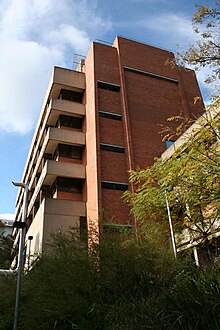John Aitken (biologist)
Robert John Aitken (born 4 September 1947)[1] is an Anglo-Australian reproductive biologist, widely known for identifying oxidative stress as a significant contribution to infertility and its actions on human sperm function.
[11] After 4 years working with Dr Roger Short, Aitken completed his thesis,[12] and received a PhD for research on reproductive study in roe deer from the University of Cambridge in 1973.
[2] However, for the first 12 months at Edinburgh, he had not done any outstanding research due to transformations in study models from descriptive on wild animals to mechanistic approaches using the mouse, as well as changes in laboratories.
[13] In late 1975, Aitken was invited to study problems associated with fertility regulation at the World Health Organisation (WHO)'s Human Reproduction Unit in Geneva.
[15] In 1977, Aitken had been appointed to the first Medical Research Council Centre for Reproductive Health at University of Edinburgh, where he and his team focused on the biochemistry of implantation.
[2] After months of waiting for clinical supplies, Aitken took the lead in Andrology with Roger Short and David Mortimer's encouragement,[2] despite the fact that the discipline was still in its infancy around the 1950s.
It was there that he discovered an abnormally free radical attack in failures of fertilisation[19] and later did research on the relationship between reactive oxygen species and their effects on impaired sperm function.
[22][23] During the time at the University of Edinburgh, Aitken worked with multiple antibodies to analyse their effects on fertilisation and human sperm function.
[24] When he gave the administration of A23187 to spermatozoa from normal fertile and oligospermia, he discovered a decline in fertilisation rates at a higher dose, which reduced sperm motility.
[27] Aitken's paper had expanded on the molecular modifications of oxidants in male infertility and resulted in new therapeutic intervention methods to maintain reproductive function.
[21] His paper in the European Journal of Pharmacology in 1990 proposed 3 possible targets, including hCG, zona pellucida and sperm surface for contraception development.
[2] It was here that he later took part in several important roles such as Head of School, Director of an ARC Centre of Excellence then Pro-Vice-Chancellor of the Faculty of Health and Medicine at the University of Newcastle.
[34] They also researched related oxidative stress problems, such as genetic alterations in male infertility, which culminated in gene mutations, discussing the possible health issues of the next generation from couples using assisted reproductive technology.
Their discovery showed the effectiveness of numerous diagnostic techniques, such as chemiluminescence, spectrophotometry, and flow cytometry, as an indicator of oxidative stress, emphasizing the general significance of mitochondrial dysregulation in impaired sperm activity.

